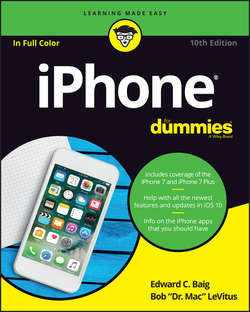Читать книгу iPhone For Dummies - LeVitus Bob - Страница 10
Part 1
Meet Your iPhone
Chapter 2
iPhone Basic Training
Activating the iPhone
ОглавлениеYou will typically activate the iPhone where you bought the thing, just as you do with other cellphones. However, if you buy your iPhone from Apple’s online store, the folks there will ship it to you and you activate it through iTunes, just like the old days, or through iCloud. If you’re already a customer upgrading from an earlier iPhone or a different phone, you can convert your plan during the ordering process. You also choose your desired monthly bucket of voice minutes and SMS (Short Message Service) or text messages as well as your allotment of wireless data minutes right in the store.
As mentioned, we aren’t going to go through all the wireless options here. Suffice to say that plans vary by wireless carrier and are subject to change. At the time this book was written, ironclad two-year contracts were rapidly becoming far less, well, ironclad. Of course, you’re still obligated to pay what you owe your carrier. Indeed, the carriers all are moving away from contracts to installment pricing.
Unlimited data plans are also in a state of flux. Verizon and AT&T used to offer unlimited data but now typically charge based on usage, though those of you who signed up for an unlimited data plan previously are grandfathered.
Many “unlimited” plans are subject to data-speed throttling after a customer reaches a certain threshold of data, though such levels are being raised in the consumer’s favor. For example, AT&T announced that customers wouldn’t be subjected to reduced data speeds and potential latencies until they consumed 22GB a month. In the past, such penalties might be imposed at around 5GB per month.
If you plan on tapping into the faster 4G LTE (Long Term Evolution) networks that the iPhone 5 and later models are capable of making nice with, you may end up consuming more data and ultimately paying more.
You may also have to fork over extra coin for a plan that includes tethering, or the capability to use your iPhone as a broadband modem for other devices you might carry, such as laptops and netbooks.
iPhones are available also from smaller regional carriers such as C Spire and U.S. Cellular.
Three prerequisites for enjoying the iPhone have been in place since the original release and remain – at least for most U.S. customers:
❯❯ One, unless you’re already in the fold, there’s the aforementioned business of becoming an AT&T, Verizon, Sprint, or T-Mobile subscriber or a customer of any other company that subsequently sells the devices.
❯❯ Two, you may have to free yourself from any wireless contract that you’ve already entered into. As we’ve pointed out, such contractual obligations are getting liberalized and ironclad two-year contracts are disappearing in favor of installment pricing. Heck, your new wireless company may even pay any early termination fees due your old carrier.
A number of retailers will at least give you a credit for your old iPhone that you can use toward a new model. The amount of the credit depends largely on the condition of the device. You must pay off the phone over a set period, again typically two years. But at least you’re shifting to the latest models.
Under its own trade-in program, Apple won’t give you cash for your old phone but will issue a gift card that you can use in the store. As of this writing, you can get a card valued at up to $250 if you trade in an iPhone 6 Plus. You can even get a $50 gift card for trading in a now ancient iPhone 4. Prices vary depending on the condition of the phone you're trading in. Keep in mind that you may get cash or a better trade-in deal elsewhere.
Apple has its own in-store upgrade program, based on a 24-month installment. As this book was going to press, you could get a 32GB iPhone 7 for $32.41 a month, a 128GB model for $36.58, and a 256GB model for $40.75. Pricing for the 7 Plus under the Apple upgrade program is $37.41, $41.58, and $45.75, respectively. You get to choose your own carrier. AppleCare warranty protection is included.
❯❯ Three, make sure you download the freshest version of iTunes software for syncing with your PC or Mac. Apple doesn’t supply the software in the box, so head to www.apple.com/itunes if you need to fetch a copy, or launch your current version of iTunes and then choose iTunes ⇒ Check for Updates (Mac) or Help ⇒ Check for Updates (Windows).
The uninitiated might not know that iTunes is the nifty Apple jukebox software that iPod, iPad, PC, and Mac owners use to manage music, videos, and more. iTunes is at the core of the iPhone as well because it has a built-in iPod, under what is called the Music app instead. You employ iTunes to synchronize a bunch of stuff on your computer and iPhone, including apps, photos, podcasts, videos, ringtones, and (of course) music – that is, unless you eschew your computer directly and manage all this stuff through iCloud.
Although iTunes is no longer required for the initial configuration of your iPhone, we recommend fetching it anyway, even if you don’t intend to use it for syncing with a PC or Mac. We just happen to be fans of the software.
